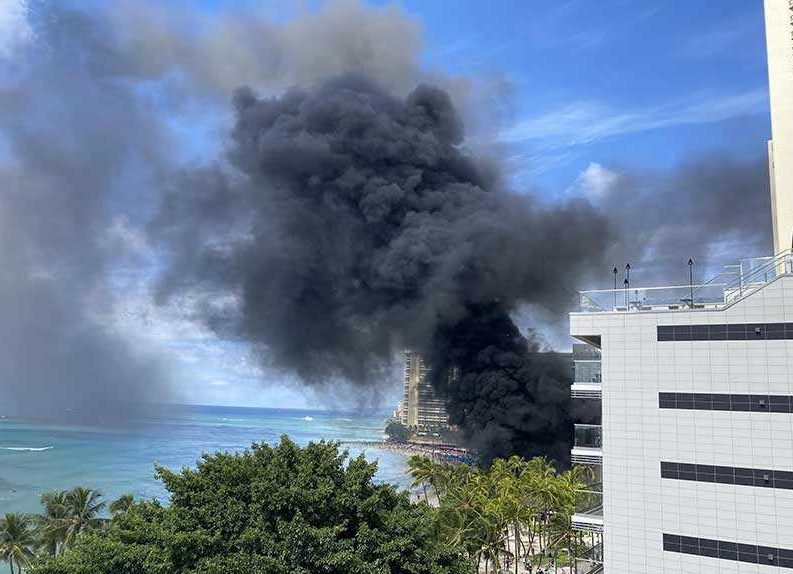
We learned that the location was the storage rack for 500 surfboards just one building from the historic Moana Surfrider Hotel; it was probably arson, and that it was the second time this happened in two years.
I had heard about the homeless situation in Hawaii—that there were many, and about locking the cars with absolutely nothing visible inside. A few people told me “even homeless people look happy there.” While it is true that life for unhoused residents is climately easier than their counterparts in the northern mainland, I failed to find happiness in them. Wisdom, yes. Compassion, yes. Quiet and desperate resignation, yes. But not happiness.
As shocking as the fire was, what struck me to the core was the yelling, more like roaring, that echoed through the canyon of brand stores and hotels, of first one or two voices, but soon joined by more. I assumed they were coming from the unhoused, because I had spent the previous night watching people from my balcony and had seen a few of them making similar roars.
It was a jarring experience on all levels—visually there could not have been more contrast, emotionally it shook me to the core, and mentally, seeing it against the background of our world where inequality is causing widespread tension. Yet—dare I say it—there was also a strange sense of beauty. It was cathartic, letting out the steam that was building from weeks and months of pretending it’s fine that our brothers and sisters are unhoused, stripped of dignity, and walk invisibly amongst so much wealth—however short-lived the release might be.
I am now back home in the Catskills, two hours north of New York City. What do I do with this energy and emotion that was stirred by this vivid memory? Transition comes to mind.
This June, my friend Liz Smith gifted me the MEA Online course. She believed this would be good for me. She was right, to my surprise. The journey that was designed by Chip and the MEA team made me realize that I had been in a transition all my life since adolescence. The financial and social struggle I had accepted as a way of life for artists and activists was a messy middle—I didn’t have to do this until I died, I could still become a butterfly and achieve the very goal that made me an artist—to give back to the world. This was life changing.
Now, as I sit by my window illuminated by the autumn sun reflecting the neon yellow green and deep reds and oranges of leaves, I’m wondering if we, as the society, were also in the VERY messy transition.
Do we have to accept inequality as necessary? Do we have to give up fighting the climate crisis and environmental degradation at the pressure of hyper capitalism? Do we keep endlessly getting divided?
What if we were in the messy middle? What if we could still become one big butterfly, as a country, as the world? What would that process look like? What would the world after transition feel like?
Furthermore—what if that process was a joyful one, not something to persevere? And along the way you build connections and a solid network to achieve concrete goals?
This is exactly what MEA and Chip achieved for individuals and small groups in their design of their framework, program, and the community. So here are the questions: What would that framework look like for society? How would you design programs to facilitate that transition?
WHAT WOULD A TRANSITION FOR SOCIETY LOOK LIKE?
As alumni or other interested readers, you undoubtedly would have ideas. Perhaps they could incorporate this as a prompt for one of MEA’s programs? 😉
Personally, I am happy to tell you that as of June of this year (same time as I started the MEA course!), I am a think tank member of Creatives Rebuild New York (CRNY), a $125M initiative, funded by the Andrew Mellon, Ford, and Niarcos Foundations, to give 2400 NY State artists basic income and 300 artists full time employment, with the goals that include narrative change and social/political impact. This is a perfect environment in which to explore the answers to the above question, including actual implementation of the result.
I was invited to the think tank almost by accident—the director found me on the internet. She contacted me through my website, without recommendations or introductions. The same digital sphere that keeps us divided and our attention disrupted could also help us reach beyond the boundaries like industries, class, culture, and education, and discover possibilities in unexpected places.
There are numerous hopeful signs as headlines fill with daunting news. My personal goal, practiced through my organization Forge Collective and my role in CRNY, is to discover and connect these signs and bring their stories to the forefront. The MEA community is one of those bright, hopeful signs.
Keiko Sono is a community-based artist and producer. She founded Forge Collective to explore how the work and social environment could be better aligned with people’s intrinsic values and motivations. She is a Think Tank member of Creatives Rebuild New York in which she helps design the basic income and employment programs for artists, including policy impacts such as the 21st Century version of the artists program of Workers Progress Administration, an influential component of FDR’s New Deal.